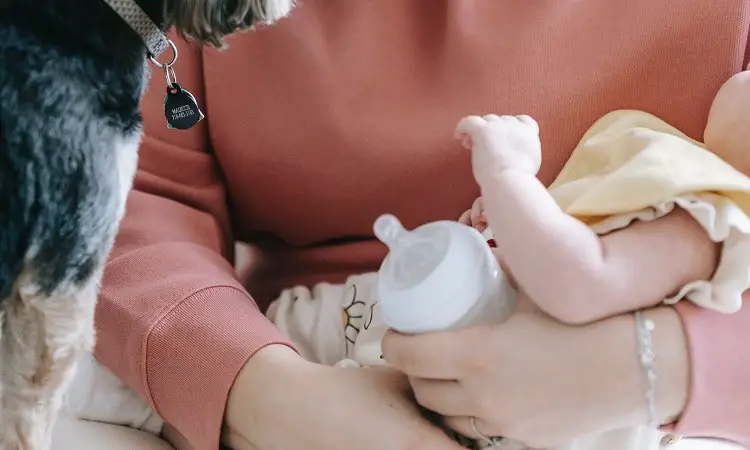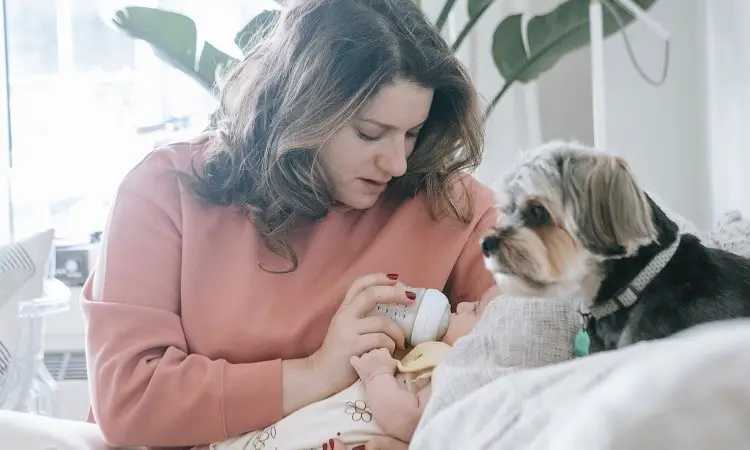Babies grow at a steady pace and it can be difficult to keep up. Is your baby fed with the bottle and you’re wondering if it’s time to go up a nipple size?
But how do you know if it’s time to switch nipple size? Did you know there were different nipple sizes and each could make a difference?
Nipple size is usually one of many choices when it comes to your baby’s feeding bottles. Knowing when to switch nipple size for your baby makes feeding sessions more comfortable and fun for everyone involved.
But how do you know which nipple size is right for your baby and when to size up or size down. In this article, we compiled this guide to understanding when to switch nipple size for formula-fed and breastfed babies.
Common Nipple Sizes

Before diving into when to switch to nipple size, let’s take a look at the common nipple sizes available.
Every bottle manufacturer is slightly different, and you may notice a bit different wording, but they all have varieties of nipples available that offer all kinds of flow rates.
Of course, this can be quite confusing at first, but it’s good to have the following options at hand to provide your baby maximum comfort during feeding time:
- Level 0/Preemie and or extra slow flow: This nipple type is the best choice for babies with an immature digestive system. The slower flow will give the baby enough time to swallow the milk before getting the next gulp. This nipple size is also perfect for newborns who breastfeeding.
- Level 1 or slow flow: This nipple type is the best choice for older, younger, exclusively bottle-fed babies who transition from breastfeeding and bottle-feeding.
- Level 2 or medium flow: This nipple type is the best choice for babies out of the newborn stage. However, always watch out to see if the baby is coughing, choking, or dripping a lot of milk dripping, which is a sign that the baby isn’t quite ready for it.
- Level 3/4 or fast flow: This nipple type is the best choice for babies who are can sit up and are ready to take in solid foods.
Read Also: Best Formula To Keep Baby Fuller Longer
When To Switch Nipple Size For Baby

Baby nipple size bottle depends on their age, whether their formula-feeding or breastfeeding and other readiness cues. And how fast your baby feeds will depend on the labeled nipple size.
For A Formula Fed Baby
For formula-fed babies, the bottle usually comes with an age guide for each nipple size. Manufacturers usually post these guides on their website, but if the guide doesn’t come with the bottles or you no longer have the package insert.
The fast flow nipples are meant for older babies since they consume more at each feeding and can handle the flow of milk better. This guideline will help you better:
- Slow flow: 0-3 months
- Medium flow: 3-6 months
- Fast flow: 6-12 months
More so, another determinant of nipple size is age. However, since all babies are different. There are several indications besides age to show when your baby is ready to move up a size, such as:
- Baby sucks hard
- Flattening the nipple
- Baby becomes fussy
- Smacking at the bottle
- Chocks while feeding
- Baby takes a long time to feed (30 min – 1 hour)
- Baby eats less but gets hungry again soon after
If your baby isn’t showing any of the above signs mentioned, then there is no need to increase the nipple size.
But if your baby is showing some of these signs we’ve mentioned, then increase the nipple size and see how your baby reacts. There’s no harm in trying.
If you happen to increase the nipple size and your baby is gagging, coughing, choking, or dripping milk by the side of his mouth, then the nipple flow is too fast and needs to be reduced.
You may also consider reducing the nipple size if your baby becomes uncomfortable after each feed, since the fast flow may be too much for his digestive tract.
Read Also: Baby Drinks Bottle Too Fast (Tips T0 Help You Cope)
For A Breastfed Baby
For breastfed babies, most experts recommend using slow flow or “newborn” nipples. Usually, you don’t need to move up a nipple size for a breastfed baby since they have to work for their milk when at the breast, and breasts usually release milk at a much slower rate than a bottle nipple.
If you offer your breastfed baby a nipple where the milk flow is right, they may begin to get lazy or even refuse your breast. Typically, the bottle flow should be just as right just like breastfeeding.
Also, bottle feeding the baby may put your baby at the risk of being overfed, therefore parents should ensure to mimic breastfeeding as much as possible and feed the baby using an upright position, then switch positions midway through, and practice paced bottle feeding.
Although most breastfed babies do not need to move up a nipple size, in certain situations a faster flow nipple might be a more suitable choice.
If You’re Exclusively Pumping
Well, since breast milk digests faster than formula and it’s quite easy to overfeed a baby when bottle feeding. According to experts, using slow flow or “newborn” nipples even if you’re exclusively pumping is best advised.
As a breastfeeding mom, you should feed your baby when the baby is hungry and not according to a rigid schedule. Also, follow paced bottle feeding technique.
A normal feeding session lasts between 15-20 minutes, so expect your nursing session to take around that same amount of time. During feeding sessions, always give your baby enough time to drink their bottle and avoid rushing through each feeding.
Related Articles:
- How To Increase Nipple Size
- How To Increase Nipple Size For Feeding
- Newborn Night Feeding Tips For First Time Moms
- Baby Best Formula That Tastes Closest To Breast Milk
Nipple Feeding Considerations
If your baby seems uncomfortable with the current nipple size, you can get both or try a different shape (such as an orthodontic or angled nipple) since nipples are quite inexpensive. More so, there are other factors you may want to consider such as texture, length of the nipple, or a different venting system.
The issue might even be the equipment itself. Your baby may be experiencing a distracting phase in his life, teething, health problems, or uncomfortable with the temperature of the milk.
You might even have a high level of lipase in your breast milk or you might probably misread your child’s cues as a sign of hunger.
Conclusion
We hope this guide has given an in-depth knowledge to answer the question of when to switch nipple size.
Keep in mind that having the right size nipple makes nursing sessions faster, easier, and much more fun for you and your baby. These sizes will depend on whether the baby is formula feeding or breastfeeding, age, and also other readiness cues.
Bottle nipple size is one baby item that isn’t a one-size fit item, so assess your situation and decide what works best for you and your baby. If the feeding session is going smooth and fun with the current size nipple, then there’s no need to switch.
